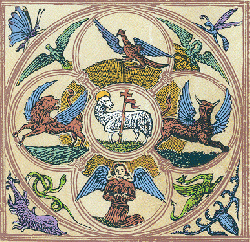Sacred Animals
Sacred Animals are present in all religious traditions in the world mythologies. Although the Judeo-Christian tradition is not usually associated to worshiping animals as being the embodiment of God (except the dove as a manifestation of the Holy Spirit) still there are animals endowed with a symbolical significance, such as the lion, the lamb, the fish, etc.
According to Mme. Blavatsky there are different keys to interpret the meaning behind the idea of sacred animals. When referred to them in a general sense, they represent some universal archetypes (prototypes):
As explained, the “sacred animals” and the Flames or “Sparks” within the “Holy Four” refer to the prototypes of all that is found in the Universe in the Divine Thought, in the ROOT, which is the perfect cube, or the foundation of the Kosmos collectively and individually. They have all an occult reference to primordial Cosmic forms and its first concretions, work, and evolution.[1]
When talking about the process of cosmic evolution, they represent the development of consciousness and the germs of animal life:
That which is meant by “animals,” in primary Creation, is the germ of awakening consciousness or of apperception . . . It is Archibiosis, or life-origination—“origination,” so far, of course, as the manifestation of life on all the seven planes is concerned.[2]
The esoteric meaning of the expression “animals” is the germs of all animal life including man. Man is called a sacrificial animal, and an animal that is the only one among animal creation who sacrifices to the gods.[3]
When used in this sense, the creation or evolution of the sacred animals precedes the emanation of the lower order of Dhyanis:
Thus, as the differentiation of the primordial germ of life has to precede the evolution of the Dhyan Chohan of the third group or hierarchy of Being in Primary Creation, before those “gods” can become rûpa (embodied in their first ethereal form), so animal creation has to precede, for that same reason, divine MAN on earth. And this is why we find in the Purânas: “The fifth, the Tairyagyonya creation, was that of animals, and—
(VI). The Urdhvasrotas creation, or that of divinities (Vishnu Purâna Book I. chap. i).[4]
The connection between the sacred animals and the angels can also be found in the Kabbalah:
The “Sacred Animals” are found in the Bible as well as in the Kabala, and they have their meaning (a very profound one, too) on the page of the origins of Life. In the Sepher Jezirah it is stated that “God engraved in the Holy Four the throne of his glory, the Ophanim (Wheels or the World-Spheres), the Seraphim, the Sacred Animals, and the ministering angels.[5]
From the "astronomical key" the Sacred Animals represent "the signs of the Zodiac".[6]
Nevertheless, even Christians have to this day their sacred birds; for instance, the dove, the symbol of the Holy Ghost. Nor have they neglected the sacred animals. The Evangelical zoolatry—the Bull, the Eagle, the Lion, and the Angel (in reality the Cherub, or Seraph, the fiery-winged Serpent), is as much pagan as that of the Egyptians or the Chaldeans. These four animals are, in reality, the symbols of the four elements, and of the four lower principles in man. Nevertheless, they correspond physically and materially to the four constellations that form, so to speak, the suite or cortège of the Solar God, and occupy during the winter solstice the four cardinal points of the zodiacal circle. These four “animals” may be seen in many of the Roman Catholic New Testaments where the portraits of the evangelists are given. They are the animals of Ezekiel’s Mercabah.[7]
In the first chapter [of Genesis], animals, whales and fowls of the air, are created before the androgyne Adam* (* An allegorical reference to the “Sacred Animals” of the Zodiac and other heavenly bodies. Some Kabalists see in them the prototypes of the animals.) In the second, Adam (the sexless) comes first, and the animals only appear after him.[8]
According to Mme. Blavatsky the second chapter of Genesis refers to what in Hinduism is known as the "secondary creation", that is, the evolution of Earth on the fourth Round. In this case, the mention of animals refers to the development of the animal kingdom.[9]
Notes
- ↑ Helena Petrovna Blavatsky, The Secret Doctrine vol. I, (Wheaton, IL: Theosophical Publishing House, 1993), 441-442.
- ↑ Helena Petrovna Blavatsky, The Secret Doctrine vol. I, (Wheaton, IL: Theosophical Publishing House, 1993), 455-456.
- ↑ Helena Petrovna Blavatsky, The Secret Doctrine vol. I, (Wheaton, IL: Theosophical Publishing House, 1993), 446, fn.
- ↑ Helena Petrovna Blavatsky, The Secret Doctrine vol. I, (Wheaton, IL: Theosophical Publishing House, 1993), 456.
- ↑ Helena Petrovna Blavatsky, The Secret Doctrine vol. I, (Wheaton, IL: Theosophical Publishing House, 1993), 92.
- ↑ Helena Petrovna Blavatsky, The Secret Doctrine vol. I, (Wheaton, IL: Theosophical Publishing House, 1993), 92.
- ↑ Helena Petrovna Blavatsky, The Secret Doctrine vol. I, (Wheaton, IL: Theosophical Publishing House, 1993), 363.
- ↑ Helena Petrovna Blavatsky, The Secret Doctrine vol. II, (Wheaton, IL: Theosophical Publishing House, 1993), 181.
- ↑ Helena Petrovna Blavatsky, The Secret Doctrine vol. I, (Wheaton, IL: Theosophical Publishing House, 1993), 455-456.
